 Considering the recent growth of “salt mining”
Considering the recent growth of “salt mining”
by Brian Leubitz
Even with recent rains, California is continuing to suffer from a historic drought. This lack of water has opened up a new front of attack on fracking technology, which suddenly is coming under scrutiny for the massive consumption of water it requires in order to break apart shale to release oil.
Anti-fracking activists are beginning to connect the dots between the drought and fracking. In addition to my own writing on the subject, a opinion piece in the community newspaper Oakland Local shows how grassroots opposition to the fracking due to its effect on water supplies is gaining traction.
And it’s not just at the local level. Just a few weeks ago, the Los Angeles Times examined how fracking is creating water supply issues in Colorado, and predicted the same may happen in California. And in Sacramento, Senators Mark Leno (D-San Francisco) and Sen. Holly Mitchell (D-Los Angeles) have introduced legislation to put a moratorium on fracking in California in part because of its potential impact on water supplies.
“A moratorium on fracking is especially critical as California faces a severe drought with water resources at an all-time low,” Leno told Reuters News Agency, “We are currently allowing fracking operations to expand despite the potential consequences on our water supply, including availability and price of water, the potential for drinking water contamination and the generation of billions of barrels of polluted water.”
Meanwhile, Assemblyman Marc Levine (D-Marin) has unveiled a fracking moratorium bill that he ties directly to the drought.
“We have to decide what our most precious commodity is – water or oil?,” Levine told Reuters. “This is the year to make the case that it’s water.”
Nationwide, the impact of fracking on water supplies has been staggering. The Environment America Research and Policy Center estimated last fall that at least 250 billion gallons of water has been used in fracking operations for 80,000 wells in 17 states.
That’s why a Tetra Technologies project in Southern California is beginning to attract attention. The Texas-based company has filed paperwork for a project in San Bernardino County with hopes of adding five additional production wells in order to expand its sodium chloride (aka salt) and calcium chloride mining production by 20 percent. (Both sodium chloride and calcium chloride are widely known to be chemicals used in fracking.)
The company’s January 2013 Mining Plan Amendment would seem to fit in with Tetra Technologies’ recent growth in the fracking industry. Earlier this month, it bought WIT Water Transfer, a firm that provides water services for fracking. Last year, it purchased Patterson-UTI Energy Inc.’s fracking services unit for $42.5 million in 2012. Yet the company has said little, billing itself as a “salt mining operation” to anyone who asks.
These moves haven’t gone unnoticed on Wall Street. Analyst Travis Holom of the popular Motley Fool financial column focused on Tetra’s recent stock gains by noting:
“Investors clearly like the growth opportunity the larger company has ahead. Texas is the big growth market right now in fracking, and TETRA’s services will be a key piece of that growth. It’ll take a while to see the financial impact, but given the growth expected next year, I think shares have room to run higher, especially as natural gas drilling picks up nationwide.”
Tetra clearly has high hopes for expanding its operations in San Bernardino. That’s why the potential environmental impacts, both locally and globally, of the proposed expansion may be cause for alarm.
Yet San Bernardino County hasn’t seemed to be taking the necessary steps to ensure full Tetra Tech’s full compliance with the California Environmental Quality Act. It’s unclear what, if any, mitigation be required. Hopefully, answers will emerge soon.

 •
•.jpg?1388346519) •
• •
•  • Pete Peterson – Republican, Executive Director of Davenport Institute at the School of Public Policy at Pepperdine University
• Pete Peterson – Republican, Executive Director of Davenport Institute at the School of Public Policy at Pepperdine University •
•  •
• 